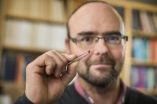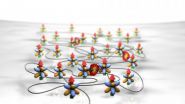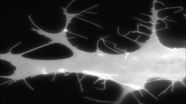(Press-News.org) Mutations within the gene FTO have been implicated as the strongest genetic determinant of obesity risk in humans, but the mechanism behind this link remained unknown. Now, an international team of scientists has discovered that the obesity-associated elements within FTO interact with IRX3, a distant gene on the genome that appears to be the functional obesity gene. The FTO gene itself appears to have only a peripheral effect on obesity. The study appears online March 12 in Nature.
"Our data strongly suggest that IRX3 controls body mass and regulates body composition," said senior study author Marcelo Nobrega, PhD, associate professor of human genetics at the University of Chicago. "Any association between FTO and obesity appears due to the influence of IRX3."
Mutations to introns (noncoding portions) of the gene FTO have been widely investigated after genome-wide association studies revealed a strong link between FTO and obesity and diabetes. Yet overexpressing or deleting FTO in animal models affects whole body mass and composition, not just fat, and experiments have failed to show that these obesity-linked introns affect the function of the FTO gene itself.
Hoping to explain these observations, Nobrega and his team mapped the behavior of promoters—regions of DNA that activate gene expression—located within one million base pairs on either side of the FTO gene. In adult mice brains, where FTO was thought to affect metabolic function, they discovered that the promoter that turns on FTO did not interact with obesity-associated FTO introns.
"Instead, we found that the promoter for IRX3, a gene several hundred thousand base pairs away, did interact with these introns, as well as a large number of other elements across the vast genetic distance we studied," said co-author Jose Luis Gomez-Skarmeta, PhD, a geneticist at the Andalusian Center of Developmental Biology in Sevilla, Spain. The researchers found a similar pattern of interactions in humans after analyzing data from the ENCODE project, which they confirmed with experiments on human cells.
Using data from 153 brain samples from individuals of European ancestry, they discovered that the mutations to FTO introns that affected body weight are associated with IRX3 expression, but not FTO. Obesity-related FTO introns enhanced the expression of IRX3, functioning as regulatory elements. The FTO gene itself did not appear to play a role in this interaction.
"Regulatory elements are switches that turn genes on and off. What we've found is that the switches that control IRX3 are far away from the gene and actually inside the FTO gene", says Nobrega.
To verify the role of IRX3, the researchers engineered mice without the IRX3 gene. These mice were significantly leaner than their normal counterparts. They weighed about 30 percent less, primarily through reduced fat.
The decrease in weight gain occurred despite normal levels of food consumption and physical activity. When fed a high-fat diet, mice without IRX3 retained the same weight and fat levels as on normal diets. Normal mice fed a high-fat diet gained almost twice as much weight. Fat cells in IRX3-deficient mice were smaller, and increased levels of brown fat were observed. In addition, these mice were better able to process glucose.
"These mice are thin. They lose weight primarily through the loss of fat. But they are not runts," said co-author Chin-Chung Hui, PhD, professor of molecular genetics at the University of Toronto. "They are also completely resistant to high-fat diet-induced obesity. They have much better ability to handle glucose, and seem protected against diabetes."
The researchers also discovered that mice with altered IRX3 function in the hypothalamus, the portion of the brain known to regulate feeding behavior and energy expenditure, showed an identical pattern of leanness as mice which completely lacked IRX3. Hypothalamic function of IRX3, therefore, appears to control body mass and composition in these animals, indicating that the genetic predisposition to obesity is wired in the brain.
IRX3 codes for a protein that regulates other genes, and is present both in and outside the brain, in organs and cells such as fat cells. Nobrega and his team are currently investigating how IRX3 interacts with genes and molecules that it regulates, and hope to identify targets for the development of novel therapies against obesity and diabetes.
"IRX3 is probably a master regulator of genetic programs in the cells where it is expressed," Nobrega said. "We're interested in what its targets are and what they alter. The goal is to identify downstream targets of IRX3 that become models for drug targeting."
INFORMATION:
The study, "Obesity-associated variants within FTO form long-range functional connections with IRX3," was funded by the National Institutes of Health. Additional authors include Scott Smemo, Juan Tena, Kyoung-Han Kim, Eric Gamazon, Noboru Sakabe, Carlos Gomez-Marın, Ivy Aneas, Flavia Credidio, Debora Sobreira, Nora Wasserman, Ju Hee Lee, Vijitha Puviindran, Davis Tam, Michael Shen, Joe Eun Son, Niki Alizadeh Vakili, Hoon-Ki Sung, Silvia Naranjo, Rafael Acemel, Miguel Manzanares, Andras Nagy, Nancy Cox, Chi-Chung Hui and Jose Luis Gomez-Skarmeta.
IRX3 is likely the 'fat gene'
2014-03-12
ELSE PRESS RELEASES FROM THIS DATE:
Building new drugs just got easier
2014-03-12
LA JOLLA, CA—March 12, 2014—Scientists at The Scripps Research Institute (TSRI) have developed a method for modifying organic molecules that significantly expands the possibilities for developing new pharmaceuticals and improving old ones.
"This is a technology that can be applied directly to many medicinally relevant compounds," said Jin-Quan Yu, a professor in TSRI's Department of Chemistry and the senior author of the new report, which appears in Nature March 13, 2014.
The innovation makes it easier to modify existing organic compounds by attaching biologically active ...
Water-rich gem points to vast 'oceans' beneath the Earth: UAlberta study
2014-03-12
A University of Alberta diamond scientist has found the first terrestrial sample of a water-rich gem that yields new evidence about the existence of large volumes of water deep beneath the Earth.
An international team of scientists led by Graham Pearson, Canada Excellence Research Chair in Arctic Resources at the U of A, has discovered the first-ever sample of a mineral called ringwoodite. Analysis of the mineral shows it contains a significant amount of water—1.5 per cent of its weight—a finding that confirms scientific theories about vast volumes of water trapped 410 ...
Quantum chaos in ultracold gas discovered
2014-03-12
The team of Francesca Ferlaino, Institute for Experimental Physics of the University of Innsbruck, Austria, has experimentally shown chaotic behavior of particles in a quantum gas. "For the first time we have been able to observe quantum chaos in the scattering behavior of ultracold atoms," says an excited Ferlaino. The physicists used random matrix theory to confirm their results, thus asserting the universal character of this statistical theory. Nobel laureate Eugene Wigner formulated random matrix theory to describe complex systems in the 1950s. Although interactions ...
Key heart-failure culprit discovered
2014-03-12
SAN DIEGO, Calif., March 12, 2014 - A team of cardiovascular researchers from Sanford-Burnham Medical Research Institute (Sanford-Burnham), the Cardiovascular Research Center at Icahn School of Medicine at Mount Sinai, and the University of California, San Diego have identified a small but powerful new player in the onset and progression of heart failure. Their findings, published in the journal Nature on March 12, also show how they successfully blocked the newly discovered culprit to halt the debilitating and chronic life-threatening condition in its tracks.
In the ...
Protein key to cell motility has implications for stopping cancer metastasis
2014-03-12
VIDEO:
Aberrant filopodia are induced by co-expression of fluorescently labeled Cdc42 and non-fluorescent IRSp53. Fluorescence shows the cell shape, because Cdc42 localizes to the plasma membrane.
Click here for more information.
PHILADELPHIA - "Cell movement is the basic recipe of life, and all cells have the capacity to move," says Roberto Dominguez, PhD, professor of Physiology at the Perelman School of Medicine, University of Pennsylvania. Motility – albeit on a cellular spatial ...
Countering the caregiver placebo effect
2014-03-12
How do you know that your pet is benefiting from its pain medication? A new clinical trial design from North Carolina State University researchers could help overcome pet owners' unconscious observation bias and determine whether the drugs they test are effective.
When animals are recruited for clinical trials, particularly for pain medications, researchers must rely on owner observation to determine whether the medication is working. Sounds simple enough, but as it turns out, human and animal behavior can affect the results.
All clinical trials have a "control" ...
'Ultracold' molecules promising for quantum computing, simulation
2014-03-12
WEST LAFAYETTE, Ind. – Researchers have created a new type of "ultracold" molecule, using lasers to cool atoms nearly to absolute zero and then gluing them together, a technology that might be applied to quantum computing, precise sensors and advanced simulations.
"It sounds counterintuitive, but you can use lasers to take away the kinetic energy, resulting in radical cooling," said Yong P. Chen, an associate professor of physics and electrical and computer engineering at Purdue University.
Physicists are using lasers to achieve such extreme cooling, reducing the temperature ...
Turing's theory of morphogenesis validated 60 years after his death
2014-03-12
PITTSBURGH—British mathematician Alan Turing's accomplishments in computer science are well known—he's the man who cracked the German Enigma code, expediting the Allies' victory in World War II. He also had a tremendous impact on biology and chemistry. In his only paper in biology, Turing proposed a theory of morphogenesis, or how identical copies of a single cell differentiate, for example, into an organism with arms and legs, a head and tail.
Now, 60 years after Turing's death, researchers from the University of Pittsburgh and Brandeis University have provided the ...
Large study identifies the exact gut bacteria involved in Crohn's disease
2014-03-12
While the causes of Crohn's disease are not well understood, recent research indicates an important role for an abnormal immune response to the microbes that live in the gut. In the largest study of its kind, researchers have now identified specific bacteria that are abnormally increased or decreased when Crohn's disease develops. The findings, which appear in the March 12 issue of the Cell Press journal Cell Host & Microbe, suggest which microbial metabolites could be targeted to treat patients with this chronic and currently incurable inflammatory bowel disease.
Twenty-eight ...
Newly diagnosed Crohn's disease patients show imbalance in intestinal microbial population
2014-03-12
A multi-institutional study led by investigators from Massachusetts General Hospital (MGH) and the Broad Institute has identified how the intestinal microbial population of newly diagnosed Crohn's disease patients differs from that of individuals free of inflammatory bowel disease (IBD). In their paper in the March 12 issue of Cell Host and Microbe, the researchers report that Crohn's patients showed increased levels of harmful bacteria and reduced levels of the beneficial bacteria usually found in a healthy gastrointestinal tract.
Several studies have suggested that ...




